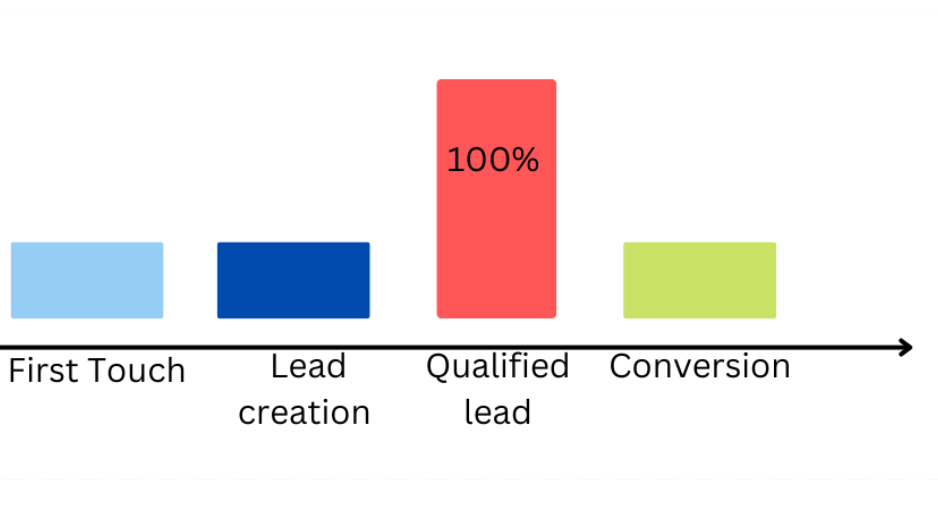Are you struggling to measure the effectiveness of your marketing efforts? In today’s complex digital landscape, businesses are turning to Multi-Touch Attribution (MTA) as a solution.
This blog article will guide you through understanding MTA and how picking the right model can boost your Return on Investment (ROI).
Key Takeaways
- Multi-Touch Attribution (MTA) helps businesses measure the effectiveness of their marketing efforts by tracking and assigning value to each touchpoint in a campaign.
- MTA models, such as linear, U-shaped, W-shaped, time-decay, full path, Z-shaped, and custom models, provide insights into customer behavior and optimize ROI.
- Combining MTA with marketing mix modeling enhances budget allocation and optimization opportunities for better business outcomes.
What is Multi-Touch Attribution (MTA)?

Multi-Touch Attribution (MTA) is a method used to analyze customer behavior by tracking and assigning value to each touchpoint in a marketing campaign, enabling marketers to attribute conversions and optimize their return on investment (ROI).
Importance of MTA
MTA is very important for any business. It lets you see the value of each place or ad that leads a buyer to make a purchase. This helps in making good use of your money as it shows what ads are doing well and which ones are not.
Using MTA can boost your bottom line by showing where to better spend your ad funds. It gives real insight into how customers behave and interact with different channels. This leads to more useful data, better decisions, and bigger profits.
Differences from single, first, and last-touch attribution
In the world of attribution models, there are key differences between single, first, last, and multi-touch attribution. Understanding these differences will help you select the right model for your business and marketing needs.
| Attribution Model | Description | Differences |
|---|---|---|
| Single-Touch Attribution | This model attributes customer conversion to a single touchpoint, typically the first or last interaction. | Unlike multi-touch attribution, it doesn’t account for all touchpoints in the customer journey, potentially missing crucial insights. |
| First-Touch Attribution | This model assigns 100% of the conversion credit to the first interaction a customer has with your brand. | In contrast to multi-touch attribution, it ignores all subsequent touchpoints which may have influenced the final buying decision. |
| Last-Touch Attribution | This model attributes customer conversion entirely to the last touchpoint before a purchase. | As opposed to multi-touch attribution, this model overlooks the entire customer journey leading up to that final interaction. |
| Multi-Touch Attribution | Multi-touch attribution (MTA) assigns credit to all touchpoints a customer interacts with on their path to conversion. | MTA provides a comprehensive view of the customer journey, allowing for deeper insights and more accurate ROI analysis compared to single, first, and last-touch models. |
Remember, selecting the right attribution model is key to accurately measuring the impact of different marketing touchpoints on customer behavior. It can unlock better budget allocation, enhance ROI, and provide valuable data-driven insights.
Types of Multi-Touch Attribution Models

There are several types of Multi-Touch Attribution models, including linear, U-shaped, W-shaped, time-decay, full path, Z-shaped, and custom models.
Linear
The linear model is one type of Multi-Touch Attribution. It gives equal credit to all touchpoints in the buyer’s journey. This model works best for long sales cycles. Here, every step matters equally to close a deal.
By using it, you can see how all your marketing efforts work together.
U-shaped
The U-shaped attribution model is one of the types of multi-touch attribution models that marketers can use to measure the effectiveness of their marketing campaigns. In this model, equal importance is given to the first and last touchpoints in a customer’s journey.
It recognizes that both the initial interaction and the final conversion are crucial in influencing a customer’s decision. This model helps marketers understand how different touchpoints contribute to conversions and allows them to optimize their marketing strategies accordingly.
By using the U-shaped model, businesses can make data-driven decisions to improve their ROI and enhance their overall marketing effectiveness.
W-shaped
The W-shaped attribution model is one of the types of multi-touch attribution models used in marketing analytics. It gets its name because it assigns more weight to three significant touchpoints: the first interaction, the middle interaction, and the last interaction before a conversion.
This model recognizes that these touchpoints have a strong impact on customer behavior and should be given greater importance when measuring ROI.
With the W-shaped model, marketers can gain a deeper understanding of how different touchpoints contribute to conversions. By analyzing these key interactions throughout the customer journey, businesses can optimize their marketing campaigns for better results.
This model allows them to allocate their budget effectively by focusing on the touchpoints that have proven to be influential in driving conversions.
Implementing the W-shaped attribution model requires careful data collection and integration across all channels. Marketers need to define their objectives clearly and ensure accurate tracking of each touchpoint.
By monitoring and iterating on this model, businesses can refine their strategies over time for improved marketing effectiveness.
Time-decay
Time-decay is one of the types of multi-touch attribution models that can be used to measure the impact of different marketing touchpoints on customer behavior. This model gives more weight to the touchpoints that occur closer to the conversion, assuming they have a greater influence.
However, it gradually decreases the importance of touchpoints as they move further away from the conversion event. While time-decay modeling can be effective for some campaigns, it may not be suitable for every marketing team’s goals and objectives.
It requires careful consideration and analysis to ensure accurate results and meaningful insights.
Full path
The full path attribution model is one of the types of multi-touch attribution models that businesses can use to analyze and optimize their marketing campaigns. This model considers all touchpoints throughout the customer journey, from the first interaction to the conversion.
It provides a holistic view of how each touchpoint contributes to the overall success of a campaign and helps identify which channels are most effective in driving conversions. With the full path attribution model, marketers can gain valuable insights into customer behavior and make informed decisions about their marketing strategies.
By understanding the complete customer journey, businesses can optimize their landing pages, PPC advertising, and other integrated touchpoints to improve ROI and achieve their business goals.
Z-shaped
The Z-shaped multi-touch attribution model is one of the many options available to marketers for tracking and analyzing customer behavior. In this model, equal credit is given to both the first and last touchpoints in the customer journey, recognizing their importance in influencing purchase decisions.
This means that the initial touchpoint that sparked a customer’s interest and the final touchpoint that led to conversion are both considered valuable in understanding marketing effectiveness.
The Z-shaped model helps businesses gain insights into which channels and strategies are most impactful throughout the entire customer journey, ultimately optimizing marketing campaigns for better ROI.
Custom
Custom multi-touch attribution models allow businesses to tailor their measurement approach based on unique needs and goals. With a custom model, companies can define specific touchpoints and assign different weights or values to each interaction.
This allows for a more personalized analysis of marketing effectiveness and ROI optimization. By creating a custom model, businesses can gain deeper insights into the customer journey, ensuring that every touchpoint is accounted for in the attribution process.
This level of customization allows for greater accuracy in measuring marketing performance and making data-driven decisions.
Implementing a custom multi-touch attribution model requires careful consideration and analysis of business goals and objectives. It involves collecting and integrating relevant data from various sources, defining key metrics, testing and calibrating the model, as well as monitoring its performance over time.
Custom models provide flexibility but also come with challenges such as the need for consistent tracking across all touchpoints and ensuring alignment with overall business objectives.
Implementing Multi-Touch Attribution

Combining multi-touch attribution with marketing mix modeling can provide valuable insights for optimizing ROI and improving marketing campaigns. Discover the benefits and challenges of implementing MTA in this article.
Combining with marketing mix modeling
Combining multi-touch attribution with marketing mix modeling is a powerful approach to optimize your marketing efforts and boost ROI. By integrating these two methods, you can get a clearer picture of how each marketing touchpoint contributes to your overall results.
It helps you understand the effectiveness of different channels, such as digital advertising or PPC campaigns, and make data-driven decisions. This comprehensive analysis allows for better budget allocation and optimization of non-revenue generating touchpoints.
Ultimately, combining multi-touch attribution with marketing mix modeling leads to enhanced marketing effectiveness and better business outcomes.
Benefits
Multi-touch attribution models offer several benefits for technology-focused businesses:
| Benefit | Description |
|---|---|
| Accurate ROI Measurement | Multi-touch attribution provides a more accurate understanding of marketing efforts’ contributions to revenue generation by considering all touchpoints in the customer journey. |
| Enhanced Budget Allocation | Businesses can allocate marketing budgets more effectively by identifying impactful touchpoints and reallocating resources based on insights from multi-touch attribution. |
| Improved Optimization Opportunities | Deeper analysis of customer behavior allows for the optimization of marketing campaigns, informed decisions about landing page optimization, PPC advertising, and other conversion tracking strategies. |
| Integrated Touchpoint Analysis | Examination of integrated touchpoints provides a comprehensive view of how different marketing channels work together, helping tailor campaigns to customer preferences. |
| Better Alignment with Business Goals | Multi-touch attribution aligns marketing efforts with overall business goals, leading to more effective marketing strategies and improved ROI measurement by identifying key touchpoints. |
| Enhanced Decision-Making | Data-driven decision-making is facilitated by multi-touch attribution, giving businesses confidence in their marketing strategies and informed choices about performance measurement, cross-channel advertising, and marketing analytics. |
Challenges
Challenges in implementing multi-touch attribution models include:
| Challenge | Description |
|---|---|
| Data Collection and Integration | Gathering accurate and comprehensive data from various marketing channels can be complex and time-consuming. |
| Defining Objectives | Clearly defining the goals and objectives of the attribution model is crucial for aligning business goals and optimizing ROI. |
| Testing and Calibration | Testing different attribution models and calibrating them to accurately reflect customer behavior can be challenging, requiring ongoing monitoring and adjustments. |
| Monitoring and Iterating | Continuously monitoring the performance of the attribution model and iterating based on new data or changes in marketing strategies is essential for maintaining accuracy. |
| Complexity of Touchpoint Analysis | Analyzing the impact of multiple touchpoints on customer behavior can be intricate, especially when considering non-revenue-generating touchpoints. |
| Attribution Modeling Limitations | No single attribution model is perfect, and each has its limitations. Understanding these limitations is important to avoid drawing inaccurate conclusions. |
| Aligning with Marketing Mix Modeling | Integrating multi-touch attribution with marketing mix modeling to gain a holistic view of marketing effectiveness can be challenging due to differences in methodologies and data sources. |
| Limited Resources for Data Analysis | Implementing multi-touch attribution requires dedicated resources for data analysis, which can be a challenge for smaller organizations with limited budgets or expertise. |
| Stakeholder Buy-In | Gaining buy-in from stakeholders, such as marketing teams or executives, who may have different perspectives on attribution models, can present challenges in implementing a unified approach. |
| Adapting to Changing Technology | As technology evolves, new channels and touchpoints emerge, requiring adaptation of the multi-touch attribution model to accurately capture customer interactions across all platforms. |
Choosing the Right MTA Model

To choose the right Multi-Touch Attribution (MTA) model, businesses need to focus on data collection and integration, defining their objectives, testing and calibration, as well as monitoring and iterating for better results.
Data collection and integration
Accurate data collection and integration are crucial for effective multi-touch attribution. Here are some important points to consider:
| Key Point | Description |
|---|---|
| Consistent Tracking | Accurately track and record all relevant touchpoints, including both online and offline interactions. |
| Data Sources | Collect data from various sources, such as website analytics, CRM systems, and marketing automation tools, to gain a comprehensive view of customer behavior. |
| Data Quality | Validate the accuracy and reliability of collected data to avoid misleading insights or decisions. |
| Integration Tools | Utilize technology solutions that seamlessly integrate different data sources for a holistic analysis of customer journeys. |
| Cross-Channel Visibility | Establish a system that provides visibility into all marketing channels and touchpoints to understand the complete customer journey. |
| Attribution Models Compatibility | Ensure that data collection methods align with selected attribution models for accurate analysis. |
| Privacy Considerations | Respect customer privacy and comply with relevant data protection regulations while collecting and integrating customer data. |
Defining objectives
Defining objectives is a crucial step in choosing the right multi-touch attribution model. This means clearly identifying what you want to achieve with your marketing campaigns and understanding the specific goals and outcomes you are targeting.
By aligning your objectives with the right attribution model, you can gain valuable insights into customer behavior, optimize your marketing strategies, and ultimately improve your return on investment (ROI).
It’s important to consider factors such as data collection and integration, testing and calibration, and monitoring and iterating when defining your objectives to ensure accurate analysis and meaningful results.
Testing and calibration
Testing and calibration are important steps in implementing a multi-touch attribution model. Here’s what you need to know:
| Step | Description |
|---|---|
| Conduct Thorough Testing | Analyze historical data and run simulations to test the effectiveness of the multi-touch attribution model. |
| Validate Assumptions | During testing, validate the assumptions made in the model to ensure it accurately reflects customer behavior. |
| Calibrate the Model | Fine-tune the model based on real-world data by comparing predicted results with actual outcomes for increased accuracy. |
| Monitor Ongoing Performance | Continually monitor the model’s performance, review results, analyze trends, and make necessary adjustments. |
| Iterate for Improvement | View multi-touch attribution models as an iterative process and use insights from ongoing monitoring to refine and enhance the attribution approach. |
Monitoring and iterating
Monitoring and iterating is an important step in implementing multi-touch attribution models. Here are some key considerations:
| Key Consideration | Description |
|---|---|
| Regular Monitoring of Data | Continually monitor data from various touchpoints to ensure accuracy and reliability. |
| Identifying Patterns and Trends | Analyze data to identify customer behavior patterns and trends for informed marketing decisions. |
| Testing and Calibrating | Continuous testing and calibration of the attribution model to ensure accurate conversions attribution. |
| Iterating Based on Insights | Refine attribution models based on insights gained from monitoring to better understand touchpoint impact. |
| Adjusting Marketing Tactics | Use monitoring and iteration to adjust marketing tactics in real-time for optimized campaign results. |
Conclusion
Choose the right multi-touch attribution model to boost your ROI. By accurately measuring the impact of different marketing touchpoints, you can make informed decisions and allocate your budget effectively.
Implementing the right model will unlock valuable insights and improve your marketing campaigns for better results. Don’t miss out on maximizing your ROI with multi-touch attribution!
Frequently Asked Questions
What is multi-touch attribution?
Multi-touch attribution is a method that helps marketers understand the impact of each marketing touchpoint on customer behavior and conversion, considering multiple interactions throughout the customer journey.
Why is choosing the right attribution model important for boosting ROI?
Choosing the right attribution model is important for boosting ROI because it allows marketers to accurately allocate credit to various marketing channels, optimize campaigns based on data-driven insights, and make informed decisions regarding budget allocation.
What are some common types of multi-touch attribution models?
Common types of multi-touch attribution models include linear, time decay, U-shaped (also known as position-based), first touch, last touch, and custom models designed to fit specific business needs.
How do I pick the right multi-touch attribution model for my business?
To pick the right multi-touch attribution model for your business, consider factors such as your industry, target audience behavior patterns, marketing objectives, available data sources and analytics capabilities; experiment with different models to find one that aligns with your goals and provides valuable insights.
Can I use multiple attribution models simultaneously?
Yes! It’s possible to use multiple attribution models simultaneously by comparing results from different models or using a combination approach like weighted average or ensemble modeling to get a comprehensive view of marketing performance.




